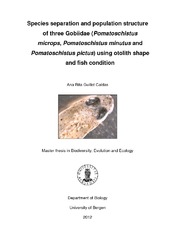| dc.description.abstract | Population structure and species separation in three species of the genus Pomatoschistus (P. microps, P. minutus and P. pictus) was studied using otolith shape and morphology and fish condition. Using a 1 m-wide beam trawl ca 2000 gobies were collected in several locations across the European Atlantic coast. Pomatoschistus minutus showed a much higher condition factor than the remaining 2 species. In the intraspecific analysis P. microps' population from Skibotn/Sørbotn showed the highest Krel, followed by the populations from Minho while in the case of P. minutus the population from Texel showed by far the highest Krel. In both species the animals collected during the summer season had the highest Krel, with the winter season scoring the lowest. In the morphological analysis the three species showed the same tendency in all the comparisons: the bigger the total length, the bigger the area, Feret's diameter and otolith weight. Also, the bigger the area, the bigger the perimeter. Contrarily, when the animal was bigger the otolith was less circular and there was a higher range in the otolith's circularity. In general P. pictus' and P. microps' otoliths have approximately proportional relationships between the variables while P. minutus' otoliths show a considerable difference: proportionally P. minutus' otoliths not only tend to be heavier in larger specimens but also larger and less circular than otoliths from the common and the painted goby. The sand goby also shows higher values of Feret's diameter. At all sizes when the painted goby has proportionally smaller and more circular otoliths than the common goby. In the intraspecific comparisons the different populations of both P. microps and P. minutus showed the same relationships between the variables as described for the species. When using all the variables combined it was not possible to clearly separate the species based on otolith shape and morphology, although the degree of separation was higher when all the populations were included. In the intraspecific analysis P. microps' populations from Minho and Skibotn/Sørbotn could be separated. The remaining population, as well as all the populations from P. minutus, showed a high degree of overlapping. | en_US |
